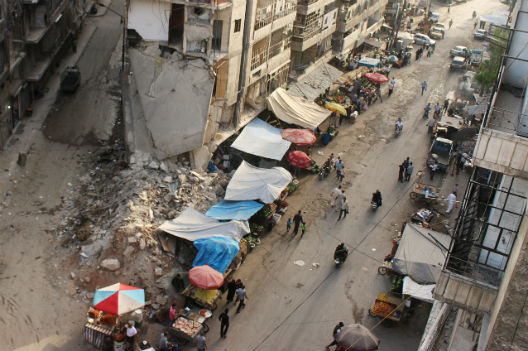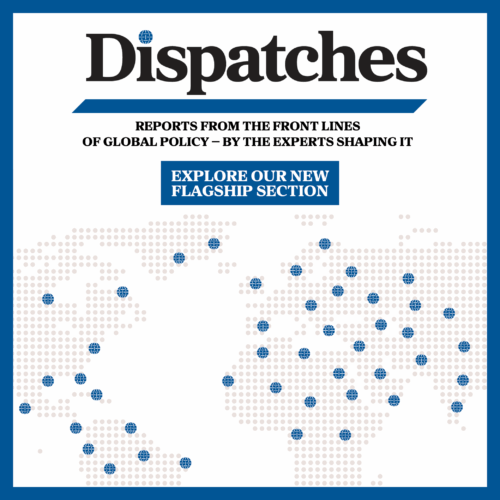 Thousands of Syrians in besieged areas across the country from all sides of the conflict fight daily to secure a livelihood and fulfill their basic needs using makeshift means, some which stand out for their spirit of innovation. Whereas some fortunate areas have been able to overcome the blockade through autonomous production initiatives and establishing systems that store and distribute provisions equally among the people, other areas have failed to break the blockade for a number of reasons, the most important being an absence of sufficient supplies amid rising population numbers.
Thousands of Syrians in besieged areas across the country from all sides of the conflict fight daily to secure a livelihood and fulfill their basic needs using makeshift means, some which stand out for their spirit of innovation. Whereas some fortunate areas have been able to overcome the blockade through autonomous production initiatives and establishing systems that store and distribute provisions equally among the people, other areas have failed to break the blockade for a number of reasons, the most important being an absence of sufficient supplies amid rising population numbers.
Although close in proximity, the situations in northern Homs, in which regime forces have trapped over 100,000 civilians and blocked all entry and exit, and the al-Waer neighborhood in the city of Homs, where the regime has 75,000 individuals un siege, differ markedly. After three years, the population of the northern countryside has been able to set up a number of local development projects, most importantly the production and storage of wheat and its delivery to residents. Meanwhile, the population of al-Waer relies completely on UN aid due to a lack of arable land.
The “Our Bread from Our Land” project in northern Homs, which now continues for its second year, has been critical in helping residents resist a stifling blockade from the Syrian regime, which barred aid convoys from entering the area for extended periods last winter. The project, which is supervised by the Local Council of Homs, is made possible by support from farmers and, in turn, fulfills their needs at the start of each farming season. In addition, the project provides farmers with financial loans insured by either humanitarian associations or expatriate families in exchange for farmers’ pledges that they will sell their yields to the council, not sell outside of the blockaded area, and not hike prices in times of distress.
According to media activist Yaarb al-Dali, the council was able to both distribute available quantities of wheat over the past year and prevent a monopoly on trade. Dali added that the price of a bag of bread decreased by 50% last year after the council opened a bakery. He also mentioned that other projects with support from humanitarian organizations may ease the blockade’s severity. One of these is a project aimed at safeguarding surface water networks, which naturally provide water to the besieged, and another aids the establishment of cheese and yogurt factories in the area in light of the lack of electricity and animal products.
Other activities carried out by civilians highlight the human capacity to adjust to all situations, a notion that Darayya in the western Damascus countryside exemplified.
Having some 250,000 residents at the end of 2012, the combination of the regime blockade and several regime massacres caused most of the population to flee. The 10,000 left inside suffered from a relentless, suffocating siege in which the regime barred UN convoys from entering until the blockade’s final days when it allowed in meagre supplies that could not last the population for more than a few days.
From the start of the siege, the people of Darayya decided to rely on what their fertile lands could produce in spite of their limited area. One of the members of the city’s Local Council says that there are hardly any families that do not rely on a small piece of cultivated land to grow wheat and various greens such as chard and spinach; even small houses are used for farming today.
Darayaa’s remarkable organization in spite of the blockade is considered one of the reasons for its military perseverance over the years. Throughout the blockade, residents have shared food equally and the Local Council has done its best to impartially oversee the distribution of any aid that reaches the city.
Correspondingly, residents have resorted to different ways of producing energy from alternative sources as a result of the regime’s continuous bombardment of the city. A media personality named Abdul Hamid al-Darani confirmed that after all petroleum resources were cut off, city residents went about operating their machinery and electrical tools using something known as “the mixture” extracted from pools of melted plastic.
According to activists, the method consists of plastic being rudimentarily heated up over fire until diesel, oil, and other industrial greases can be extracted from it. According to al-Darani, these products are 80 percent similar to the original materials.
However, this method is “dangerous to some extent, as any mistake can cause a sudden explosion leading to death, burns, or disfigurement.”
As for the western Damascus countryside in which the regime has blockaded thousands of civilians, tunnels controlled by opposition forces remain the main entry point for food and medicine, particularly in the aftermath of the regime’s recent seizure of arable lands in Eastern Ghouta.
As a result of military operations, prices in the besieged region fluctuate and sometimes reach 25 times what they are in Damascus proper. In fact, any news of a reduction or influx in resources affects prices in Ghouta, as happened in November 2015 when the price of a kilogram of sugar shot up from 400 to 1,000 liras in only three hours. Likewise, the news of a 15-day ceasefire in Ghouta had a positive direct effect on prices, which dropped immediately even though it later came out that the agreement was never implemented.
In light of major price hikes, the local population relies almost entirely on charity organizations and money transfers from refugees to their families via intermediaries working across opposition- and regime-controlled areas.
In the past, some local initiatives that helped the population improve their lives spread, such as putting waterwheels in river channels to produce electricity. In fact, residents even went about using organic waste to produce “a natural gas pit” of methane gas. This project had positive effects on Ghouta according to journalist Ayham al-Omar, who saw it as a “secure source of gas that can then be used to produce electricity. This method relies on the principle of fermenting organic waste and extracting natural butane gas from it.”
The population has also benefitted from wind energy by installing wind turbines on the roofs of houses that are capable of producing up to 12 volts of electricity in one hour on a gusty day. Using these turbines, residents are able to charge their energy-storing batteries and use them for a number of electrical needs.
The latest popular inventions in Eastern Ghouta produce limited amounts of gas from empty packaging, lighters, air fresheners, insect repellant, perfume, and other used products. Similarly, small gas turbines that rely on locally sourced oil and glycerin have recently become widespread.
Al-Omar stresses that support for these types of small projects helps to lessen the severity of the blockade and reinvigorates the region by returning people to work and getting markets moving again.
The blockade differs in severity from region to region, with the neighborhoods of Deir Ezzor considered to be the hardest hit by this blockade because of their lack of resources and the absence of any local administration to assist residents as the result of the fighting between the regime and ISIS.
The estimates of the number of people living under siege in the Syrian conflict differ. The United Nations estimates put the number at over half a million while non-government organizations like the Dutch PAX and the US Syria Institute estimate that more than a million people suffer from an “increased risk of death” in 46 besieged towns because of deficiencies in food, electricity, and water.
Until the global community and state actors are able to end the suffering in Syria, some believe it is the responsibility of humanitarian organizations to support the residents’ perseverance by aiding the development of autonomous production initiatives. Perhaps the most pressing issue is that of finding a humanitarian solution for the thousands of those stranded in the war zone.
Hosam al-Jablawi is a Syrian citizen journalist.
Image: PHOTO: Vendors sell produce along a damaged street, during the holy fasting month of Ramadan, in Aleppo's Al-Shaar neighborhood June 27, 2015. REUTERS/Abdalrhman Ismail

